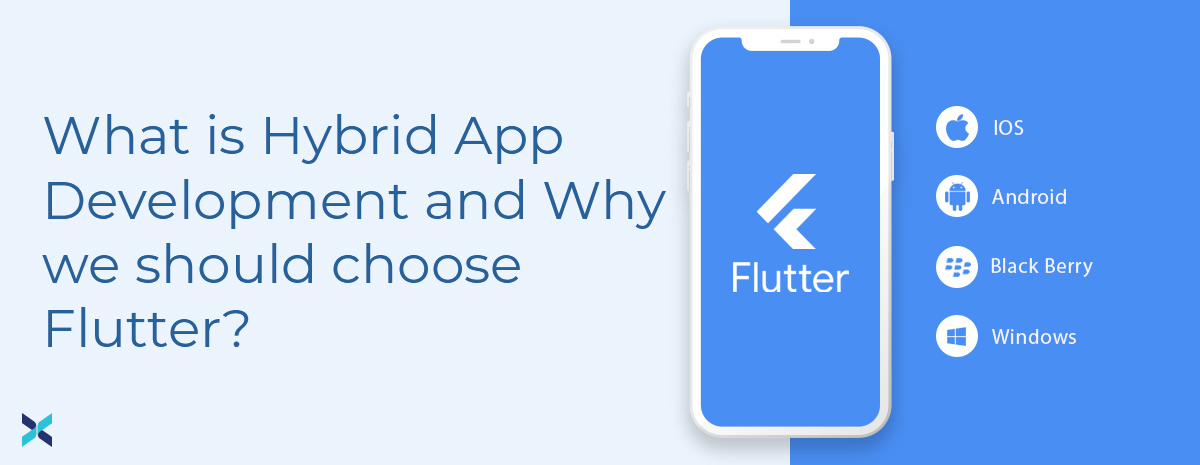Why Choose Google's Flutter For Hybrid App Development?
The mobile app marketplace has exploded in size over the past decade, thanks to the widespread availability of mobile devices and the increasing prevalence of Internet use. With more than 6.3 billion people(statista) worldwide using smartphones, it's little wonder the mobile app market is booming.
As the number of people who own smartphones continues to expand, so does the need for sophisticated hybrid apps. Therefore, businesses are always on the lookout for cutting-edge technologies and solutions that will assist in communicating with a wide range of target customers.
Hybrid apps, which may function on more than one platform, are essential for companies to compete in the rapidly evolving field of mobile app development. Flutter app creation has also become popular in recent years. In this blog, we'll learn what a hybrid application is and why Flutter is the most excellent choice for developing it.
Hybrid App Development: Overview
Hybrid app development involves designing a single application with a framework that targets all needed platforms. Hybrid apps have a lot of appeal because they can be developed from a single code base that can be utilized for several platforms. Hybrid application development is extremely attractive to businesses because it allows them to enter the mobile market simultaneously on all major platforms.
Top 5 Benefits of Hybrid App Development
1. Affordable Development Costs
The lower costs associated with hybrid app development are a primary incentive for its implementation. You can use the same team of developers and engineers to create codes for several platforms.
The costs associated with developing a project are reduced because separate tool subscriptions are unnecessary. A single platform and one set of code are required for the development of a hybrid app.
2. Widens Audience Reach
Native applications are limited in their ability to reach a wide audience. For instance, if you create an app for the Android operating system, you'll be able to reach just the people who run that system. Likewise, if the app is just designed to work on a web browser, you will miss out on the mobile market.
These illustrations highlight the fact that the audience for native apps is extremely niche. However, when you build a hybrid app, you can reach out to a wider audience with the same program.
3. Natively Immersive
While native programs have several downsides, we cannot dispute the comprehensive user experience. The UX of a hybrid app is very close to that of a native app regardless of the operating system.
Let's say, for the sake of argument, that you have built an app for both the Android and iOS platforms. A user of the Android operating system can now utilize the app and take advantage of the specialized capabilities it offers for that platform.
We think it's a great way to get people invested and start forming lasting relationships with them. Because of the consistency of the native user interface across devices, you can expect a better reaction rate from your customers.
4. Improves The App's Functionality
Native apps are limited in their ability to deliver fast performance since they require highly specialized servers. All sorts of variables, such as server traffic, frequency, and downtime, play a role in these estimates. That's why many businesses prefer hybrid solutions. These applications don't rely on any one specific server. As a result, the performance will be unparalleled by any other use case.
5. Attractive UI
Outstanding UI elements are readily available in hybrid applications, which is one of their main advantages. Everything from the available fonts to the available buttons and other interactive elements is based on the latest developments in the currency market. As a result, there will no longer be any obstacles to creating hybrid apps with cutting-edge functionality and user-friendly design.
Flutter: Overview
Google's latest initiative, Flutter, a framework for hybrid apps, was released in 2017. It's a framework for writing programs that makes it simple to create apps that run natively on a variety of devices. However, throughout development, you will only need to focus on a single code snippet at a time.
Flutter has addressed many problems that plagued hybrid app creation. Since its introduction, this has gained widespread use among businesses of all sizes.
For new businesses, Flutter could be a boon that helps them get off the ground. Most businesses seek Flutter developers so they may release cutting-edge software products in response to consumer demand. Approximately 42% of firms have utilized Flutter for their hybrid app development.
Architecture of Flutter
Learning Flutter's architecture or layering can help you better understand how it works for hybrid projects. Here, we break down the Flutter control flow in order to set the stage for successful MVP and full-scale program development.
1. Embedders
In order to fully utilize Flutter's native capabilities, your apps will require suitable embedders. Every OS-specific embedder was designed to work exclusively with that OS. Your app will be locked out of the system unless you use an embedder.
Most of the embedders are for the C and C++ programming languages. The finest Flutter apps take advantage of capabilities like threading setup, native extensions, app wrapping, render surface preparation, and an event loop interface.
2. Flutter Engine
The Flutter engine is the platform's primary component. Only Java has the JVM; the Flutter engine is tasked with facilitating the creation of the whole framework. The built-in application programming interfaces can be used to add new functionality.
You can go into things like visual layouts, plugin frameworks, and entry points for people with disabilities. Furthermore, you are free to develop your own text formats and compiler toolchains.
3. Flutter Frameworks
It will be impossible to create high-quality apps without learning more about the Flutter frameworks. Classes, modules, extensions, and other such components cannot be obtained in any other interactive medium. There is a hierarchical arrangement of various frameworks, such as:
- Foundational classes comprise the building blocks of a curriculum.
- Rendering framework for the design of abstract layout components.
- The widget layer can be used to define a flexible widget-based architecture in code.
- The Material libraries include iOS-specific control components.
Reasons To Use Flutter When Creating A Hybrid App
All Of Your Code In One Place, Thanks To Dart
The Flutter framework is built around the Dart programming language. This means that a single programming language may be used to develop hybrid mobile applications that can run on a wide variety of operating systems. Dart's codebase is flexible enough to allow for the creation of customized widgets. Dart is a cross-platform programming language, meaning you won't need to understand the specifics of each platform's native SDK.
Numerous Animated Elements
While creating a Flutter app, you can take advantage of a wide variety of animation libraries. Improve the user interface and user experience of your hybrid mobile app by using a wide variety of special effects.
You can create unique animations using the widget library. Thus, Flutter facilitates the development of an attractive mobile UI framework by providing a set of tools for creating fluid animations.
Consistency Across Multiple Channels
Flutter's ability to run consistently across platforms has made it the go-to for developers of hybrid mobile apps. Since Flutter uses its own rendering engine, you can make UIs that look the same across platforms. If you're looking to build a hybrid mobile app, Google says Flutter is the second best option after React Native.
Hyper-Reactive Architecture
Flutter simplifies the creation of hybrid mobile apps because it is a highly reactive framework. The features and functionality you enjoy in native apps will be available to you here as well.
By adjusting the app's state variables, you may easily change the app's user interface in Flutter. The interface will update itself automatically to reflect the new settings.
One-Step Approach
To create hybrid mobile applications that are both powerful and user-friendly, Flutter is the best option for businesses. It helps you save resources while you create hybrid mobile applications.
Furthermore, it employs a single codebase foundation, making it easier to develop mobile apps that run across multiple platforms. When compared to developing apps in their native environments, flutter hybrid app development using Flutter is significantly quicker.
Conclusion
Google's Flutter app development framework is rapidly growing. In addition to its many useful features, the framework also has the added benefit of helping commercial enterprises succeed. There is no better time than now to make the switch to Flutter from another framework for creating hybrid apps.
 Jignen Pandya
Jignen Pandya





